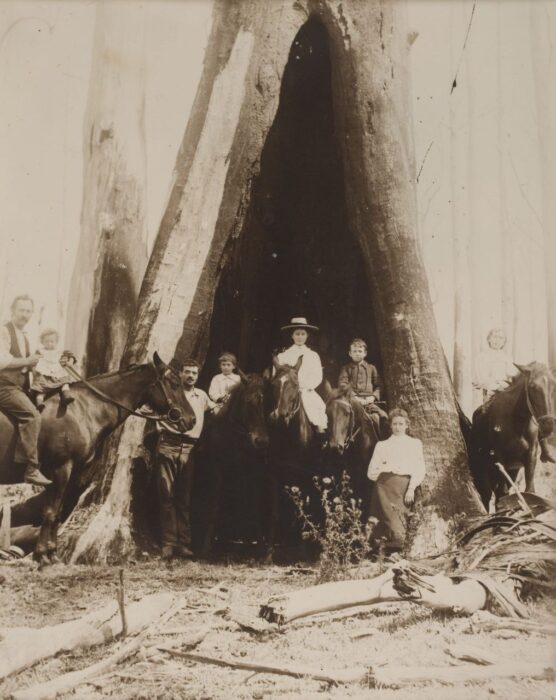Foundationally important to the pursuance of Australian nationalist objectives is not merely to navigate the narrative ‘as we find it’, but to shape it, to grapple with the history of this continent and this nation in order to better provide a credible and legitimate perspective that underpins the advancement of our legitimate ethnic interests.
It is often tempting for patriotic-minded people to recoil themselves from all things Australian, as they might wrongly perceive that Australian identity is somehow part of the same process of deracination and national decay which has so overwhelmingly taken root in this country, as it has much of the Western world. We say that not only is this retreat from Australian identity un-necessary, but it is actually counter-productive and arguably a betrayal of our heritage.
It is true that Australian identity is not cut out of whole cloth, it is inseparable from the founding stock of this country who were predominantly English, Scots and Irish in their heritage with a sprinkling of continental European nations in the mix. Over the course of time and circumstances, these much similar, kindred races have (in varying degrees, depending on the location) amalgamated into a uniquely identifiable Australian ethnic identity, or as P. R. Stephensen writes:
“We are in extraction solidly and stolidly pure British of the nineteenth century, homogeneously British, ninety per cent. British. The ten per cent. minority comprises Germans and Danes, who become assimilated immediately, with a sprinkling of Latins and “sundries,” who become assimilated in one generation… It is nonsense to say that Australia is becoming “Americanised,” as despondent English people often do say, observing our departures from the parent type. Australia is merely becoming Australianised.”
It is true that “Australianisation” as we romanticize and which Stephensen references here never truly reached an unquestionable cultural dominance on the entire population of this continent. For most of our history there has been, often for good reason, significant immigration numbers in Australia, of course, principally of Anglo-celtic stock and it is often the case that these migrants settled themselves in urban areas of Sydney, Melbourne and the other capitals of the Commonwealth which, by merit of this demographic density, retained a stronger diaspora attitude.
Children born of the third generation to the soil and those pioneers who went out to the remote interior were the bedrock of the Australian culture which we uphold and was slowly adopted by the children of those diaspora over the years which themselves grew up under the shade of the wattle tree, to the song of the magpie and felt their heart-strings plucked by the songs of a sentimental bloke, the freckled girl waiting for her love on the slip-rails and the young smiley who finally got his gun!
Without reiterating another long form discussion on Australian identity, for the purpose of this article, we assert that ours is an organic and legitimate ethnic identity that has been forged in the Australian continent for over two hundred years and that it is not accurate to state that Australian identity is merely Anglo-Celtic or merely White or merely European; it is something more, it is an emerged ethnic identity with its own attitudes, perspectives and cultural trappings which have been forged in the unique trials and triumphs of the Australian people particular to our own time and place.
When the enemies of the Commonwealth decide to drape themselves in our national flag, shall we then abandon it too? in a never-ending retreat over our cultural and national heritage? shall the brave young men of the AIF who died for our commonwealth have their memories sullied because we concede narrative control to the cosmopolitan left? This is an analogous consideration to the subject of Australian identity being surrendered.
We must not concede Australian identity to the enemy to let them do what they please with it. We must persistently assert control over what it truly means to be an Australian; to defend the true meaning of our unique, time and place ethnic identity: membership of which is not merely based on values, but it is, as is the same for all other ethnic identities, based on descent, values, loyalties, speech and culture that are both derived from our historical heritage in Europe and our more recent history in the great southern land.
It is critical in the battle for the soul of our nation, to proudly take up the mantle of Australian identity, to sharpen it, cut out the cancers that have grown around its ankles and bathe it in our unique national heritage, to cherish it, to love it and to advance it.
Do you think, where, in place of bare fences, dry creeks,
Clear streams and green hedges are seen —
Where the girls have the lily and rose in their cheeks,
And the grass in mid-summer is green —
Do you think, now and then, now or then, in the whirl
Of the town life, while London is new,
Of the hut in the Bush and the freckled-faced girl
Who waits by the slip-rails for you?
M. K. Grant
National Governor
October 2025
